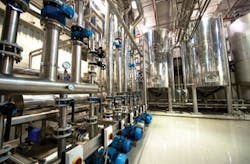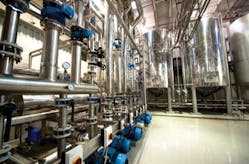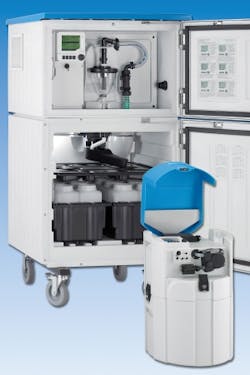By Jim Lauria
Steady population growth and green lawns put significant pressure on Utah water supplies. Several Utah cities have installed networks of purple pipes to deliver irrigation water to residents, an investment utility managers say pays off in the long term and the short term.
"It saves drinking water and also prolongs the life of the culinary system," said water operator Jeremy Robertson of the Riverton City Water Department in Riverton, Utah, using the local term for potable water. "We're using drinking water for drinking and also by not having the great flows through the culinary system, it's easier on the pumps. It really saves on wear and tear."
With more than 35,000 residents to supply, Riverton's water department draws drinking water from a series of wells. In 1999, the city began installing infrastructure for a separate irrigation water supply to most of the city; by 2008, the system was completed, delivering irrigation water no longer drawn from potable water supplies.
Riverton's irrigation water – which, unlike the city's drinking water, doesn't need to be pulled from underground aquifers or treated to drinking water standards – is a bargain for homeowners on city water. The steep discount on irrigation water spurs adoption and assigns monetary value to water based on the cost of processing it and its value to the user.
"A lot of people pay a lot of money to water their lawns with culinary water – it's expensive," said Robertson, who lives on just over a quarter-acre in Riverton, served by the city's irrigation water system. "Some of them are paying upwards of $200 to $300 a month just to water their lawn. I pay a flat fee of about $40 a month based on the size of my lot."
Five Zones
The irrigation water is drawn from various canals into storage reservoirs, then transferred among those reservoirs as needed and into the city system, said Robertson. If the demand is high enough, water can be directed straight to the filter station and then into the city, instead of being distributed to other reservoirs.
The system is set up like an irrigation installation, with five zones. The high-pressure system from Black Ridge Reservoir brings in water at 231 psi, which is reduced to 110 psi and served to residents. The low-pressure system from a lower-elevation, 1-million-gallon storage reservoir operates at 85 psi.
Fish in the reservoirs take care of most of the algae from the surface water system, said Robertson, so the city runs water from storage through six Amiad EBS automatic self-cleaning screen filters to remove sediment before pumping the water to rate payers.
The filters are set to clean themselves as needed. When a target differential between the clean and dirty side of a screen is reached, a valve on the filter opens to atmospheric pressure. Pressure from inside the filter pushes water from the clean side of the screen through the dirty side into a cleaning nozzle, drawing filter cake into the nozzle from a one-square-inch area of the screen. A set of nozzles scans the screen in a spiral pattern, drawing trapped sediment off the entire screen surface without interrupting the filtration process.
Efficient Back Flush
The back flush system is highly efficient, consuming less than one percent of the total flow volume, or 75 percent less back flush water than sand media systems. That's an important detail for Bruce Ward, public works director/city engineer for Salem City, Utah. His system also uses the Amiad EBS system. Back flush water is directed to tidy gravel envelopes next to picturesque pump buildings, where it soaks into the ground.
Uphill from one of the Salem City pump stations, irrigation water enters a settling pond from the historic Strawberry Highline Canal, a century-old system that transfers water from the Colorado Basin to the Bonneville Basin. There, a half-inch mesh screen blocks gravel and debris. A one-eighth-inch screen strains smaller solids as water leaves the settling pond for the filters and pump station. Ward said he switched from 140-micron screens to 300-micron screens in his Amiad filters to reduce the amount of back flushing by the filters.
"The station's back flush counter indicates it's only back flushed 47 times since we turned it on in June," he said in September. That has been easy for the gravel pads to absorb.
Architectural Touches
Salem's two pump and filter facilities look like miniature fire houses, painted in earthy shades of brown and tan and augmented by architectural details like courses of textured cinderblock and lap-sided roof peaks. Handsome molded concrete and cast-iron fences keep passers-by away from the buildings without creating an imposing, prison-like atmosphere.
That's all part of the long-term thinking that went into the $13 million project from the start, said Ward.
Planners realized that Salem – whose population is growing by four to five percent per year – will spread to surround the pump stations soon. Making the buildings visually pleasing and anonymous makes them less of a target for both neighborhood ire and vandalism.
"We spent extra money to make these buildings fit into nice neighborhoods," Ward said. "These fences are easy to scale, but so far nobody's taken out a spray can. Some people ask, ‘why did you spend so much on a nice building?' but other people ask me what goes on in there. I think that's great – when they look so nice people don't even know what they are."
Under Pressure
Each of the Salem pump stations has three electric pumps – one 15-hp unit and two 25-hp pumps – to maintain pressure throughout the entire system. With the steel doors shut, the system runs quietly, which is vital for a neighborhood installation that does most of its work during the night.
"We have an ordinance that doesn't allow watering between the hours of 10 am and 6 pm, so all our demand happens between six in the evening and 10 the next morning," Ward said.
The same sort of ordinance applies in nearby Spanish Fork, Utah, where John Waters points out that developing an irrigation supply system is not a game of averages.
"Our demand is concentrated between 1:00 am and 4:00 am," Waters said. "You have to make sure you oversize rather than aiming for ‘just right' or undersized. When people water, they all water at the same time, so you'll have massive use and then a very small use."
Accommodating 35,000 residents – a 33-percent increase over the past decade – Spanish Fork pumps 10,000 gallons per minute into its pressurized irrigation system from a combination of river and well supplies. Unlike his counterparts in Riverton and Salem, Waters has his EBS filters flush on a 15-minute interval rather than on a pressure differential. The small amount of back flush water, carrying minor amounts of sediment, is channeled back into the river.
Overnight demand and automatic self-cleaning filters mean an irrigation system filter station spends most of its time unattended, Waters said. That means periodic challenges like power outages can present an often-unseen challenge.
"Put in a backup electrical system to run the controls," he advised, pointing to Spanish Fork's Kohler generator, which is assigned solely to running pumps and filter back flush controls. "Otherwise, if the power goes down, people in town don't know they're not getting water through, so they drain the lines. Then when the power goes on, the system wants to fill the lines back up. Water hammer and pipe breakage become a possibility if the controllers suddenly just opens the valves all the way to refill the system."
To Meter or Not To Meter
Another piece of technology Waters endorses is water meters at each household. Spanish Fork installed 9,000 home meters when it built its pressurized irrigation system in 2003, and uses them to bill rate payers 93 cents per 1,000 gallons. That's the key to conservation, said Waters.
"One way of encouraging the conservation of water is to meter it and charge for what is actually used," he said, pointing out that meters raise awareness of a commodity that is typically taken for granted.
In Salem, residents insisted on a $25-per-month flat user fee rather than metered use.
"It just wasn't in the politics of this community to have meters," Ward said.
To encourage conservation through a different approach, Salem created the Salem Smart Yard Program. Through the program, the city installed weather-controlled sprinkler timers on its municipal sprinkler systems, which helped crews cut irrigation use in half, and bought 200 more timers to give free to conservation-minded homeowners. However, Ward said only about 100 have been installed, and two customers have even given them back to the city.
"A lot of people are afraid of the controller," he said. "They say, ‘this is just a way for the government to tell me how much to water my lawn,' or, ‘it didn't water the way I would.'"
That frustrates Ward, who believes watering based on weather conditions, as well as metering, can help manage the resource at all levels.
"Even if you weren't going to bill from the meters, I would still meter and monitor use," he said, pointing out that conservation of irrigation water can add years of longevity to systems like Salem's.
"If we just used what we needed, our systems would last 30 percent longer without needing additional capital improvements," he said. "Do the math. If we are serving 5,000 people now, we could add up to 2,000 more homes without having to install new equipment." WW
About the Author: Jim Lauria is Vice President of Marketing and Business Development for Amiad Water Systems, a manufacturer of clean technology water filtration systems for municipal, industrial, agricultural and commercial applications. He holds a Bachelor of Chemical Engineering degree from Manhattan College and has over 20 years of global experience as a senior executive in the water treatment industry.
More WaterWorld Archives Issue Articles





